by chris ayres | Mar 2016 | UK to New Zealand
After a few more days at Ile a’ Vache it was time to move on once more, so after a quick trip ashore to buy bread I made ready to sail and finally bid goodbye to Marc and Jeff the boys who had been my almost constant companions these past few days.
Out of the bay I hoisted sail and ran out down the wide channel between the mainland and the island. Rounding Point l’ Abacou I could set my course to run parallel to the coast and with 2 reefs in the main and staysail set progress with the strongish winds quite rapid and the swell not too troubling. There certainly are some big mountains in Haiti so the scenery was quite spectacular. The wind was not too last though and shortly after sunset it was dropping so contrary to my usual practise I had no reefs in this night instead had all plain sail set and progress was slow. At least I had a full bright moon. I could alter course more northwards now for Cuba, aiming to clear the extensive shoals that extend westwards from Cap Tiburn. A sudden wind increase at 3 in the morning shook me from my torpor and I put the first reef in the main followed shortly by the 2nd. Of course no sooner than the 2nd reef went in the wind dropped again, ah well.
Dawn revealed Navassa Island well off to port. It remained in sight for hours as I drifted and sailed in very light winds and near calms all morning. Eventually however we got a little wind and so it continued throughout our 2nd night with a little short lived rain squall to liven things up.
Dawn revealed just empty seas all around just some cloud to the north. Mid morning and the mountains of Cuba could be seen but as the day wore on the wind dropped again. An assessment of the situation mid afternoon was that at present speed (about 1.5- 2 knots) I would not arrive
before dark and not fancying entering a strange port at night it was on with the engine. So it was that I entered the channel leading to Santiago de Cuba and anchored off the marina at Punta Gorda just before sunset.

Castillo del Morro, approach to Santiago
In the morning I dinghied to the dock to pick up the doctor and took her back to the boat. She asked me a few questions and took my temperature and pronounced me free from any “lergies” . They take their health seriously and want to keep Cuba healthy. Then I visited the coast guard and answered their questions, no forms to fill in, all on computer these days. They then inspected the boat, content with letting their sniffer dog , a cute little docile spaniel, have a good snuffle around. Then clearance and visa issued and I was in Cuba.
First thing was to get some money. I was offered a lift into Santiago, about 10 miles by a German who had a car. This was too good an opportunity to miss so I hurriedly grabbed a few things from the boat and into Santiago I went. Kurt dropped me at the Hotel de Santiago. Here I got some convertable pesos and then had a wander around, getting a bit lost but not too badly. It is a big sprawling city but first impression very clean, none of the litter and garbage strewn about that you see in Domincan Republic. Old american cars a plenty, MZ motorbikes which brought back memories of my time as a motorcycle mechanic, horse drawn carts, big trucks which acted as buses. I bought a few veg at a farmers market and eventually took a taxi back.
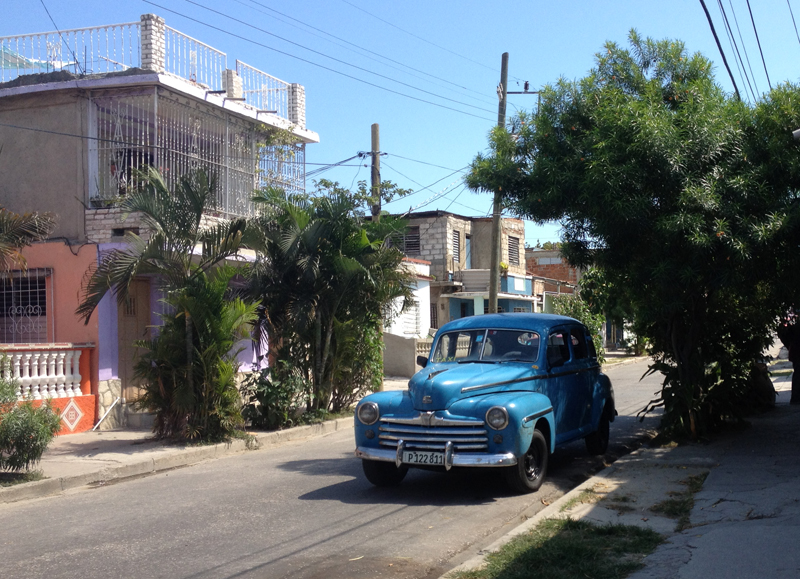
Car & street Santiago
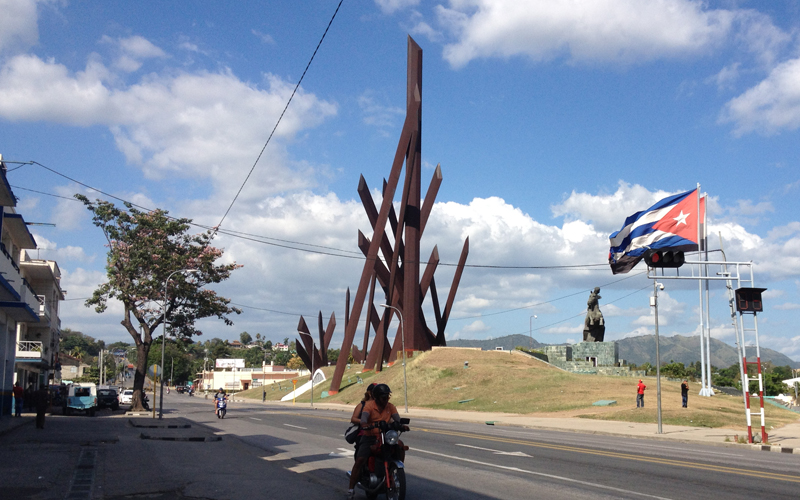
Plaza Revolution
by chris ayres | Apr 2016 | UK to New Zealand
I spent a few days anchored at Punta Gorda, took a ferry into Santiago a few times to wander around ,see the sights and listen to the music. i also cycled out to Castilla del Morro and called in at a little beach for a swim. I also went for a walk to a prominant limestone bluff inland by tiny paths through the bush and on top buzzards soaring just feet above my head. The Norwegians lads, Olaf and Knut had arrived too, but they are off eastwards and northwards. I am still westward bound. I was ready to leave but strong northerly winds were forecast for Cabo Cruz so I delayed a day or two before leaving. Next stop down the coast was Chivorico, a tight entry between the reefs into a lovely little lagoon. On again to Marea del Portillo and easier entry into a big lagoon this. My first eve there and the 30+ knot northerly arrived as dark fell, the anchor dragged so I put out the Bruce as a second anchor. In the midst of this the Guarda arrived in a little rowing fishing boat, they were having quite a struggle in the wind and I was surprised to see them on on a night like this. Ashore was a little fishing village, this was rural untouched Cuba, lovely. I got some peppers tomatoes and cucumbers from a plot farmer,he wanted some fishhooks so I gave him some.
A short hop took me to Ensenada Tiburcio, I didn’t like this entry, it started off easily enough well marked with bouys but thereafter it was unmarked between a shoaling shore and unmarked reefs.
The anchorage at Cabo Cruz is reached around a long breaking reef but at least well marked and is some way from the town and the lighthouse.
Ashore I met with a lovely Dutch couple of “Bandos”. We had seen each others boats in various place but never meet before.
The next stretch was the Gulf of Guacanayabo and Gulf of Anna Maria and the Jardines de la Reina. This is a labyrinth of hundreds of uninhabited cays, reefs and shoals. There are just a few fishermen but otherwise I would be on my own, few cruisers come this way, it is wilderness unspoilt. The pilot guide recommends a good bow watch to look out for shoals and coral, being on my own meant I would have to do without, this led to a degree of apprehension about this stage.
To the next anchorage was too far to make in daylight so I left just before dark aiming to arrive at the entrance to the Canal de Cabenza del Este, which leads into the inshore passage behind the reefs by daylight. Here I would enter into the gulf of Guacanayabo.
It turned out to be a wild night, the wind got up and barely dropped below 30 knots all night, I was down to the third reef in the main and a reef in the staysail and of course I arrived at my waypoint for the canal whist still dark so decided to hove to for a while till dawn. With the wind out of the NE it was quite a battle to head NE through the canal, bashing into a nasty short chop and finally to Cayo Granada to drop the hook.
The following days I transited the Canal de Rancho Vieja and Canal del Pingue leading into the gulf of Anna Maria. The word canal gives the wrong impression, there are no banks as such you are sailing through what looks like open waters with the occasional reef and cay visible and some marker posts to guide you, but stray of track and you will be aground on the shoals! A series of anchorages at Cayo Chocolate, Cayo Manual Gomez, Cayo Ingles, where I passed to the outside again then Cayo Breton , Cayo Macho de Afuera and finally arriving at Casilda. It had been a very intense experience, the peace, the silence were outstanding at times but it had been hard work, concentration needed at all times.

music in the plaza

Cabo Cruz




by chris ayres | May 2016 | UK to New Zealand
Casilda is the nearest port to the town of Trinidad, this is a lovely historic city, one of the oldest in the New World founded in 1514 and is one of UNESCO’s World Heritage sites. Well worth a visit and I spent a couple of days wandering around its cobbled streets.

streets of Trinidad

On then to Cienfeugos about 35 miles down the coast. Here there is a fairly narrow entrance to a big enclosed bay and you anchor off the marina. A walk down the Malecon takes you into the busy city. There are some fine old colonial buildings and a nice plaza and I soon discovered my favorite bar where you could sit outside in the shade under a colonnade, drink beer and watch the world go by.

Ceinfuegos

One day I took the bike and headed out into the country past vast orchards of mangos then just wild country side. After about 16 miles I ended up at Playa Blanca, a nice little beach so swam before heading back. Saw a real vaquero, complete with leather chaps and lariat as well as lots of horse drawn traps and of course old american cars.


All too soon my time was up , my Cuban visa had run out so although I could have renewed it, time to leave and move on. next stop the Cayman Islands
by chris ayres | May 2016 | UK to New Zealand
Of Caves and Dragons
I left Cienfeugos a little later in the day than I hoped, put it down to bureaucracy, settling my anchorage bill with the marina and then getting a dispatchio from the authorities. They visit your boat before issuing you that and exit stamps on your passport for a quick search, probably to check you have no Cubans aboard. So it was about 2.30 before I weighed anchor by which time the wind had switched to the south so a head wind for leaving, fortunately not too strong. Outside the bay progress was slow, I couldn’t lay the course I wanted, away from the coast took me SSW and I certainly didnt want any westing in my course, the other had me gradually closing the coast which trends NW-SE here. The other big danger to avoid was the Banco de Jagua lying some 25 miles offshore, unmarked with dangerous seas and numerous wrecks. The wind shifted to a more easterly direction after sunset but then fell in strength till we had barely a light breeze. Eventually though I was clear of all dangers, just empty seas between me and the Caymans.
In the early hours we had some wind back but by midday almost a flat calm. I even resorted to motoring for a while. That night was weird there was lots of phosphorecence and the sea so flat and glassy that the stars were reflected in it. I was dozing below when the wind returned, at last we could make progress. I spotted the island, a low smudge on the horizon just before noon and later in the afternoon picked up a mooring at Scott’s Anchorage, Cayman Brac.
The authorities came to meet me on the dock and were going to come out to the boat to complete formalities but looking at the size of my dinghy decided to do it ashore. I just had to ferry the mosquito control officer out to spray the inside of the boat.
Ashore later I had Cayman Island style shrimp for dinner and a few beers. I was in a bit of culture shock, there was a supermarket with everything you could wish for for sale, after months of very basic stores and not being able to get things this was wonderful and of course English was the language, no more struggling to get by in spanish or french as I had for months.
Both the islands are small, about 9 mille long by 2 wide, about 1,500 people live on Cayman Brac whilst on Little Cayman the resident population is about 150, the people are very friendly.
Exploring Cayman Brac I was offered a lift and was taken along the the Bat cave, fascinating but saw no bats. Walking back I visited Rebecca’s cave then hiked across the salt pond trail back to the North side of the island, hard going this across tortured sharp eroded limestone, in flip flops too.

Track across Cayman Brac
Next day I sailed across to Little Cayman, I though to take a mooring in Spot Bay but discovered the dock there, old and concrete too high to land on from a dinghy. I moved on around to Owens Sound, entered through a very narrow gap in the reef with breaking waves either side, scary and once inside calm but very shallow, around 2 metres with shoal patches. Pleased to be in and secured to a stout mooring bouy.
Little Cayman is famous for its iguanas, a number live around and under the old museum so that was my first stop . What wonderful beasts they are iguanas everywhere I looked, stopping at a respectful distance one big one about 4 ft long eyed me up and then came across, stopping about 2 ft short of me.
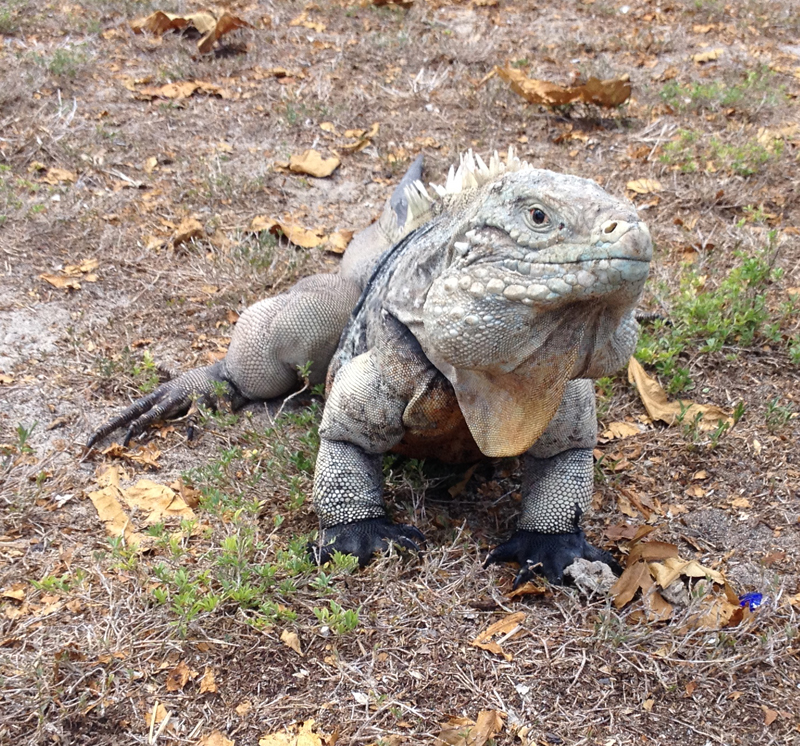
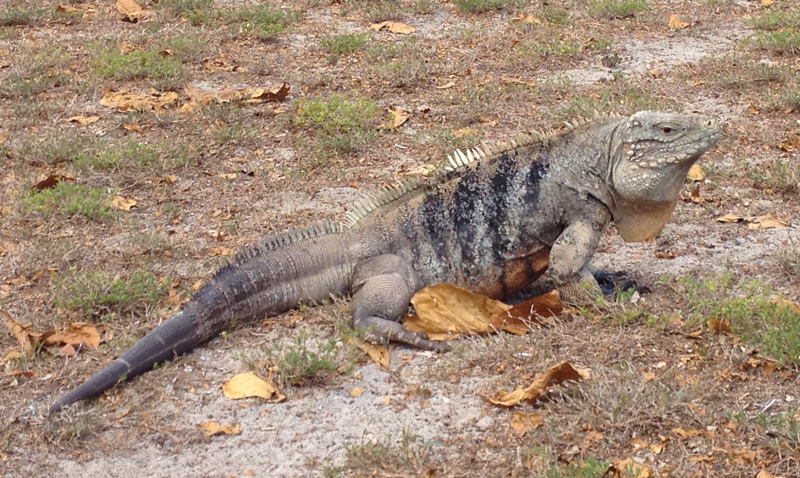

I rode my bike around the island, about 20 miles but it felt longer, traffic count 2 cars 4 iguanas. Stopping of at Sandy point the SE tip was a beautiful white sandy beach with azure sea protected by a fringing reef. Had the place to myself had a lovely swim.

Sandy Point Little Cayman

Sunset Owen’s Sound
It blew hard in the early morning with torrential rain, had a bit of a fright when I thought the mooring might be dragging so found myself stark naked in the rain and dark putting out the anchor, washed the salt off I suppose. Turned out it was just the long scope on the moooring.
Leaving through the reef was worrying with a swell running in from the south after the blow, just line up the range markers astern, aim for the middle of the small gap between marker post and buoy and then for that gap in the breakers outside, safely out phew!
Back on Cayman Brac I cycled and walked up the coast to the Brac, a big limestone cliff, home of many caves and walked up the lighthouse steps to Peter’s cave, used as a hurricane shelter by the locals.

Peter’s Cave
The other way I hiked part of the trail through the parrot reserve, didn’t see any parrots though.
I could have stayed longer on these delightful peaceful islands but if I wanted to visit Jamaica before heading out of the hurricane zone. It was time to move on.
by chris ayres | May 2016 | UK to New Zealand
Getting my clearance to leave and talking with the immigration officer on Cayman Brac. He mentioned the Cubans that had arrived a few days ago, they have no visas so will get deported back to Cuba. Apparently 2 or 3 boats arrive in the Caymans a month, crossing over a 100 miles of open sea in what a basically just lash ups, Some he said were so bad you could see the water bubbling in through the planks. He pointed out the latest, drawn up on the rocks near the dock and said that was one of the better ones. So there are still Cubans desperate enough to leave Cuba to risk all in barely seaworthy boats.
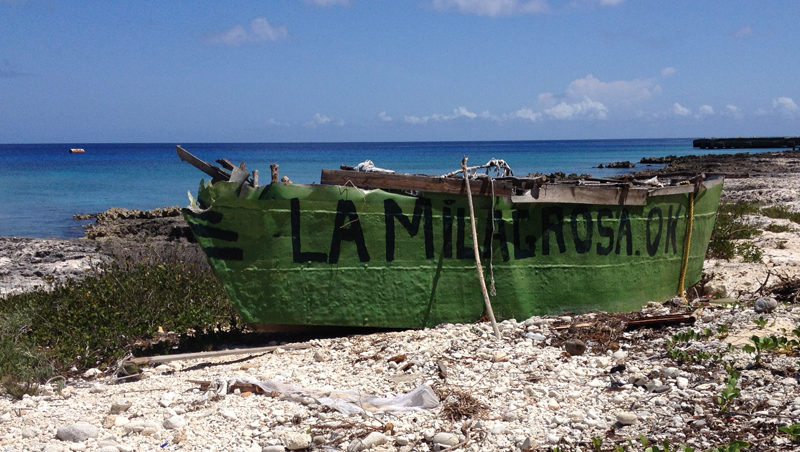

by chris ayres | May 2016 | UK to New Zealand
Talking with some locals in a bar the eve before I left Cayman Brac they told me they had heard that bad weather, a NW’erly was due tomorrow night. They were a bit incredulous saying that they just don’t get that sort of weather this time of year. I decided to clear out anyway since there are no protected anchorages here and I should be well away from the island by the time it arrived. First light next morning I got my clearance from immigration as arranged and left. I got a good start but by late morning the skies were looking increasing ominous and I confess I was a little worried. We soon had torrential rain and thunder. Still I had plenty of searoom, about a 100 miles away lay Jamaica so could afford to heave to and ride anything out if necessary. Later in the afternoon we were hit by a big squall, I had furled the yankee and had 2 reefs in the main but boy did it blow 35 – 40 knots and such torrential rain as I have never seen. It was awesome, still Sea Bear ploughed on on course whilst I sheltered on the companionway steps, raingear on just in case. It did pass and the wind drop but the skies were still dark and full of rain so I held on to not much sail, reluctant to increase it in the circumstances. A migrating swallow joined me seeking shelter from the storm and settled down to roost in the lee of the rolled up dinghy on the foredeck. Later after dark the wind shifted through 180 degrees as the front passed, the skies started to clear a little and the odd star appeared, the worst seemed to be over. Just after dawn the swallow left but returned later for a while .
A tanker bound for Houston passed, rare to see another boat in these waters. So the day gradually passed and I was joined by another little bird on passage who rested awhile perched on the pushpit. Another night and now I could see the loom of the lights of Jamaica still about 47 miles away. By dawn the coast was revealed and late morning saw me anchored opposite Montego Bay Yacht club.
I spent a few days here, visiting the “Hip Strip” a tourist haunt and the town . Its a town of two parts, inclusive hotels, tourist shops and gated residential developments and the town, all noise, smells, bustle, crowds, street stalls. Only about 50 miles down the coast was Ocho Rios but against the wind and current it took more than 24 hours and lots of tacking to get there. Another place that is very tourist orientated with big hotels and private beaches but the local part of town was interesting but I didn’t stay long clearing out the morning a big cruise ship arrived in the bay.
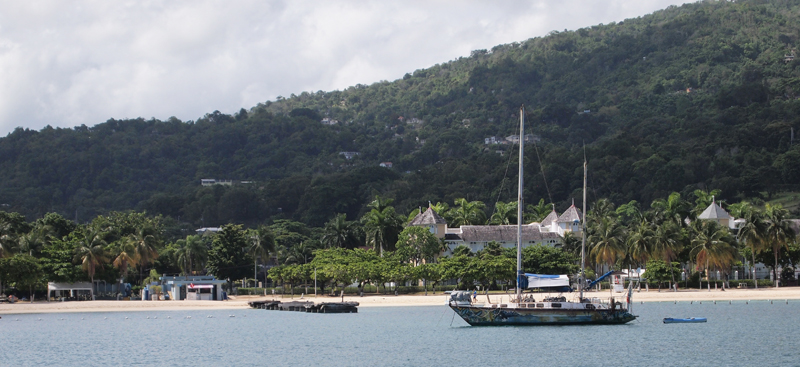
Ocho Rios
Another hard journey against wind and current eastwards to Port Antonio. At one point after tacking way from the coast and then back in I found myself closer to where I had left from than my destination. All night tacking back and forth and I seemed to be going backwards. I resolved this by motoring, much as I dislike to. Soon I was passing the Blue Mountains, very beautiful and well named and eventually turned in to the twin bays of Port Antonio and picked up a mooring off the Errol Flynn Marina.
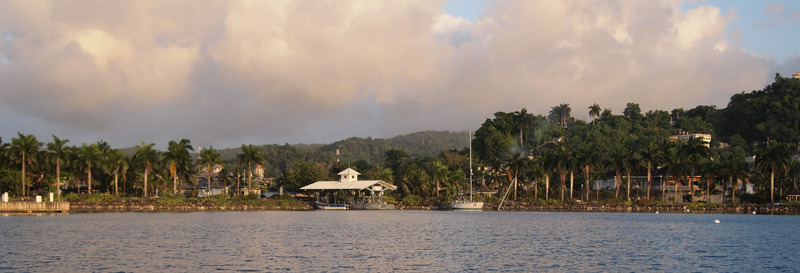
Port Antonio
This place was much more to my liking, virtually no tourists, no big hotels, no cruise ships. A very beautiful place nestled up to the foot of the blue Mountains, a well sheltered bay and a nice little town, just local Jamaican life, lots to see and do.
One day I took a bus to Kingston, the road going through the mountains, steep wooded hillsides, gorge like valleys. Got of in downtown Kingston by mistake it was even a bit much for this intrepid traveler. I have never seen a fight before by “bus loaders ” over poaching customers – real gangster stuff. Went to the Bob Marley museum in his old house, a little bit of a pilgrimage really.
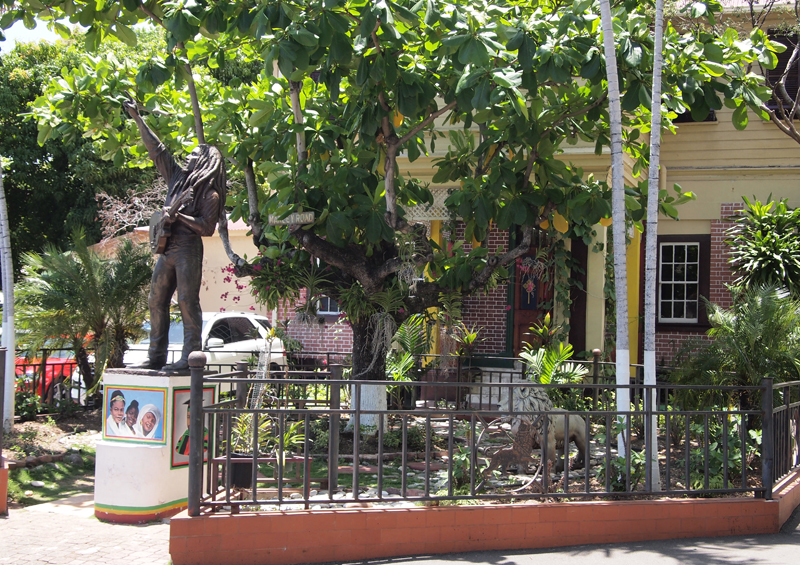
Bob Marley Museum
Another day a bus along the coast to Boston Bay, repudtly the place for the best jerk pork in Jamaica. A lovely cove of a bay, sandy beach so had a lovely swim followed by jerk pork and a beer and some rum and later another swim a great day.
I Port Antonio I became quite friendly with the owner of a little beer and rum shack on the corner entrance to what the local call “back central”, the entrance to the market. Opposite was like smokers corner with a wonderful array of characters and the sweet smell of ganga in the air all quite open. Had some good conversations over the time I was there with the owner about Jamaica and its “problems” and he looked after me, warning me of the dodgy characters and sending away the worst of the hustlers, yes there are plenty of hustlers in Jamaica. One eve they set up a sound system nearby which was great until the police turned up in flak jacket and automatic rifles – they didn’t have a permit apparently.
Labour day is a big holiday and they had a big named sound system set up at Bikini Beach, just near where the boat was moored. I went along in the eve, quite an experience, sound blaring out and the girls “shaking their booty” and rum flowing.
It is however rainy month in Jamaica so we are having our fair share of rain, generally soon over but just had a day and night of rain with plenty of thunder and lightening in the night. It is perhaps a reminder that the season is getting on. I will have to leave Jamaica shortly and head south out of the hurricane zone before the start of the hurricane season.
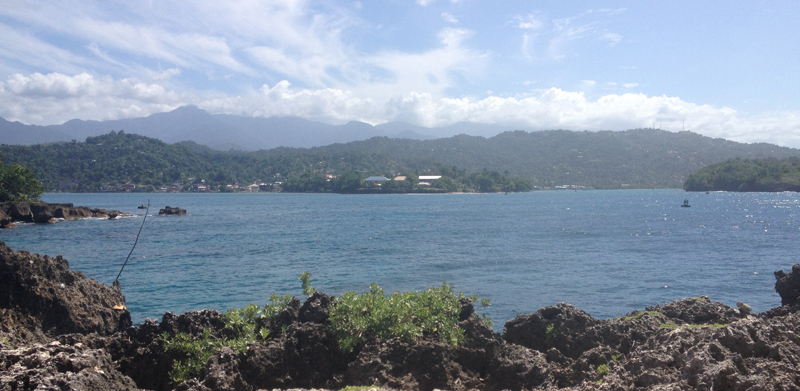
Port Antonio from Folly point



























